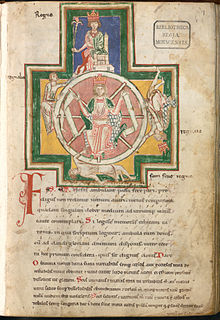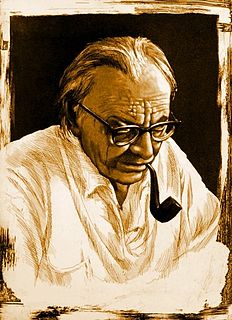Related Research Articles

Carl Orff was a German composer and music educator, best known for his cantata Carmina Burana (1937). The concepts of his Schulwerk were influential for children's music education.

Carmina Burana is a manuscript of 254 poems and dramatic texts mostly from the 11th or 12th century, although some are from the 13th century. The pieces are mostly bawdy, irreverent, and satirical. They were written principally in Medieval Latin, a few in Middle High German and old Arpitan. Some are macaronic, a mixture of Latin and German or French vernacular.

Catulli Carmina is a cantata by Carl Orff dating from 1940–1943. He described it as ludi scaenici. The work mostly sets poems of the Latin poet Catullus to music, with some text by the composer. Catulli Carmina is part of Trionfi, the musical trilogy that also includes the Carmina Burana and Trionfo di Afrodite. It is scored for a full mixed choir, soprano and tenor soloists, and an entirely percussive orchestra – possibly inspired by Stravinsky's Les noces – consisting of four pianos, timpani, bass drum, 3 tambourines, triangle, castanets, maracas, suspended and crash cymbals, antique cymbal, tam-tam, lithophone, metallophone, 2 glockenspiels, wood block, xylophone, and tenor xylophone.

Trionfo di Afrodite is a cantata written in 1951 by the German composer Carl Orff. It is the third and final installment in the Trionfi musical trilogy, which also includes Carmina Burana (1937) and Catulli Carmina (1943).

De temporum fine comoedia is an opera or musical play by 20th-century German composer Carl Orff. It was his last work and took ten years to compose. Its premiere was at the Salzburg Music Festival on 20 August 1973 by Herbert von Karajan, the Cologne Radio Symphony Orchestra and RIAS Kammerchor, staged by August Everding. In this highly personal work, Orff presented a mystery play in which he summarized his view of the end of time, sung in Ancient Greek, Latin, and German.

"O Fortuna" is a medieval Latin Goliardic poem which is part of the collection known as the Carmina Burana, written early in the 13th century. It is a complaint about Fortuna, the inexorable fate that rules both gods and mortals in Roman and Greek mythology.
Christopher Chapman Rouse III was an American composer. Though he wrote for various ensembles, Rouse is primarily known for his orchestral compositions, including a Requiem, a dozen concertos, and six symphonies. His work received numerous accolades, including the Kennedy Center Friedheim Award, the Grammy Award for Best Classical Contemporary Composition, and the Pulitzer Prize for Music. He also served as the composer-in-residence for the New York Philharmonic from 2012 to 2015.

Carmina Burana is a cantata composed in 1935 and 1936 by Carl Orff, based on 24 poems from the medieval collection Carmina Burana. Its full Latin title is Carmina Burana: Cantiones profanae cantoribus et choris cantandae comitantibus instrumentis atque imaginibus magicis. It was first performed by the Oper Frankfurt on 8 June 1937. It is part of Trionfi, a musical triptych that also includes Catulli Carmina and Trionfo di Afrodite. The first and last sections of the piece are called "Fortuna Imperatrix Mundi" and start with "O Fortuna".
Rotae Passionis is a piece for mixed chamber ensemble by the American composer Christopher Rouse. It was commissioned by Boston Musica Viva and completed in 1983, when the work was first performed. It is dedicated to Carl Orff, who died the previous year.

Angels' Carol is a popular sacred choral piece by John Rutter for Christmas. He wrote his own text, beginning "Have you heard the sound of the angel voices", three stanzas with the refrain "Gloria in excelsis Deo". It has been part of recordings of collections of Christmas music, including one conducted by the composer.
Symphony No. 3 is an orchestral composition in two movements by the American composer Christopher Rouse. The work was jointly commissioned by the St. Louis Symphony, the Baltimore Symphony Orchestra, the Royal Stockholm Philharmonic Orchestra, and the Singapore Symphony Orchestra. It was completed February 3, 2011 and premiered May 5, 2011 by the Saint Louis Symphony under David Robertson at Powell Hall in St. Louis, Missouri. The piece is dedicated to Rouse's high school music teacher, John Merrill.
Rapture is an orchestral composition in one movement by the American composer Christopher Rouse. The work was commissioned by the Pittsburgh Symphony Orchestra and was completed January 9, 2000. It is dedicated to then Pittsburgh Symphony Orchestra music director Mariss Jansons and premiered in May 2000.
Der gerettete Alberich is a concerto for percussion and orchestra by the American composer Christopher Rouse. The work was jointly commissioned by the London Symphony Orchestra, the Cleveland Orchestra, the Philadelphia Orchestra, and the Baltimore Symphony Orchestra. It was completed June 7, 1997, and premiered January 15, 1998 in Cleveland, Ohio with the Cleveland Orchestra under conductor Christoph von Dohnányi. The piece is dedicated to percussionist Evelyn Glennie, who performed the solo during the world premiere. Rouse composed the work as an informal musical sequel to Richard Wagner's four-opera cycle Der Ring des Nibelungen.
The Concerto for Orchestra is an orchestral composition by the American composer Christopher Rouse. The work was commissioned by the Cabrillo Festival of Contemporary Music and is dedicated to conductor and frequent Rouse collaborator Marin Alsop. The piece was completed February 24, 2008 and premiered at the festival August 1, 2008, with Marin Alsop leading the Cabrillo Festival Orchestra.

Concert de Gaudí is a concerto for classical guitar and orchestra by the American composer Christopher Rouse. The work was jointly commissioned by Norddeutscher Rundfunk and the Dallas Symphony Orchestra for the guitarist Sharon Isbin, with additional contributions from Richard and Jody Nordlof, to whom the piece is dedicated. It was completed August 1, 1999 and premiered in Hamburg, January 2, 2000, with Isbin and the Norddeutscher Rundfunk Orchester led by conductor Christoph Eschenbach. The piece was later awarded the 2002 Grammy Award for Best Classical Contemporary Composition.
Envoi is a single-movement orchestral composition by the American composer Christopher Rouse. The work was commissioned by the Atlanta Symphony Orchestra with additional contributions from Thurmond Smithgall. It was first performed May 9, 1996 in Atlanta Symphony Hall, Atlanta by the Atlanta Symphony Orchestra under conductor Yoel Levi. The piece is dedicated to Rouse's mother, who died in the summer of 1993.
Kabir Padavali is a song cycle for soprano and orchestra set to the poetry of the Indian mystic Kabir by the American composer Christopher Rouse. The work was commissioned by the Minnesota Orchestra for the soprano Dawn Upshaw. It was first performed by Upshaw and the Minnesota Orchestra under the direction of David Zinman in Minneapolis on January 6, 1999. The piece is dedicated to the composer's son, Adrian Rouse.
Berceuse Infinie is an orchestral composition by the American composer Christopher Rouse. The work was commissioned by the Baltimore Symphony Orchestra and was completed on July 1, 2016. It was first performed by the Baltimore Symphony Orchestra under the direction of Marin Alsop at Joseph Meyerhoff Symphony Hall on November 30, 2017. The piece is dedicated to Marin Alsop.
"Ecce gratum" is a medieval Latin Goliardic poem written early in the 13th century, part of the collection known as the Carmina Burana. It was set to music in 1935/36 by German composer Carl Orff as part of his Carmina Burana which premiered at Frankfurt Opera on 8 June 1937. Within Orff's Carmina Burana, this song is the 5th movement in section 1, Primo vere.

"O Fortuna" is a movement in Carl Orff's 1935–36 cantata Carmina Burana. It begins the opening and closing sections, both titled "Fortuna Imperatrix Mundi". The cantata is based on a medieval Goliardic poetry collection of the same name, from which the poem "O Fortuna" provides the words sung in the movement. It was well-received during its time, and entered popular culture through use in other musical works, advertisements, and soundtracks beginning in the late 20th century.
References
- 1 2 3 4 5 Rouse, Christopher (1990). Karolju: Program Note by the Composer. Retrieved August 27, 2015.
- ↑ Wigler, Stephen (November 7, 1991). "With 'Karolju,' Rouse tries to capture season's spirit". The Baltimore Sun . Retrieved August 27, 2015.
- ↑ Kosman, Joshua (December 23, 2007). "CD Reviews: Karolju - Classical". San Francisco Chronicle . Retrieved August 27, 2015.
- ↑ Amacher, Julie (December 12, 2007). "New Classical Tracks: Contemporary carols with a familiar ring". Minnesota Public Radio . Retrieved August 27, 2015.
- ↑ Burton, Anthony (January 20, 2012). "Karolju - Christmas Music". BBC Music Magazine . Retrieved August 27, 2015.